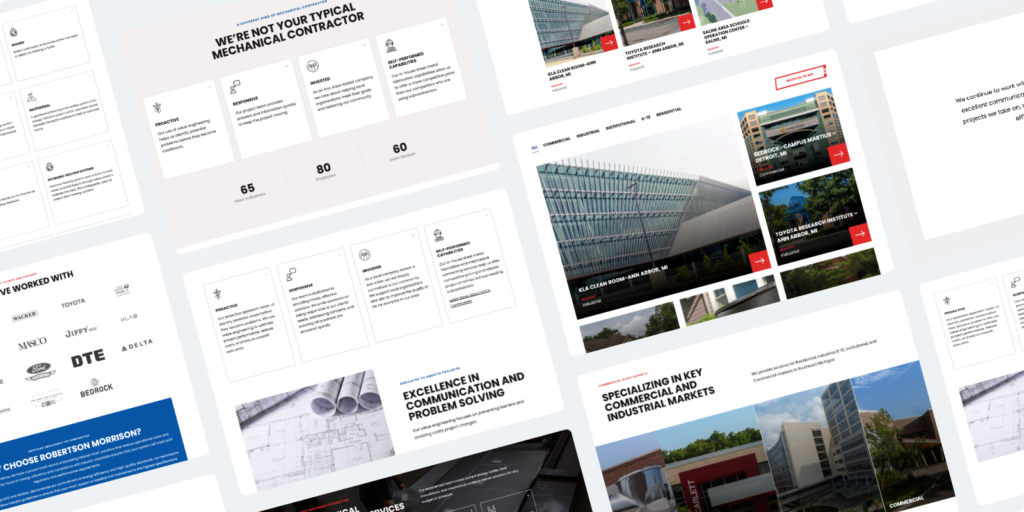- Digital and Design Strategy
- Website Redesign
- Updated 03/05/2025
Why Discovery First Projects Make Your Website More Successful

As of the time of writing this, there are over 1.95 billion websites on the internet, with that number growing every day. That means regardless of what industry you’re in, there’s a ton of competition. To give your website a legitimate chance, and subsequently your business a legitimate chance of succeeding, you need proper planning.
A proven way to ensure proper planning for a website of any scope is through discovery first projects. In this post, we’ll explain what discovery first projects are, how they work, and the impact they can have on your website. We’ll also provide resources for getting started.
Some Startling Statistics
Global business advisor McKinsey & Company performed extensive research on the success rate of modern IT projects like websites and software design. And they made some illuminating discoveries with the results being less than ideal.
According to their research, 93% of projects run over time, 45% go over budget, and 56% deliver “less value than predicted.” Further, they found that a startling 17% of projects “go so bad that they can threaten the very existence of a company.” And that’s not the type of success rate most businesses want to hear when launching a website where creating a robust, intuitive, UX-friendly site heavily impacts the longevity of their company.
While there can be numerous factors that lower the success rate, one of the most common is simply a lack of planning. This brings us to the topic of this post.
What Are Discovery First Projects?
Nielsen Norman Group defines discovery as “a preliminary phase design process that involves researching the problem space, framing the problem(s) to be solved, and gathering enough evidence and initial direction on what to do next. Discoveries are crucial to setting design projects off in the right direction by focusing on the right problems, and consequently, building the right thing.”
Occurring toward the beginning of the web design process just after onboarding, the purpose of a discovery project is to gain a deep understanding of your business’s needs and primary objectives.

What a Discovery First Project Focuses On
It typically involves assessing three main groups of people — key stakeholders, end users, and competitors. To gather necessary information, stakeholders and your target audience will be interviewed, and a competitive audit will be performed. And if you already have an existing website, a user behavior audit will also be done to see how people currently use your site.
During the discovery phase, psychological buyer models are created to identify precisely who you’re targeting, understand their psychology, and figure out what motivates them and what influences their behavior. Competitors are analyzed to decide the most effective way to approach your unique value proposition (UVP) to stand out. And key performance indicators (KPIs) are determined so that progress can be measured later on — something that’s integral for continual refinement and optimization.
To gather the right information, a series of questions are asked such as the following:
- Who are the specific stakeholders in your company that will be involved in the project?
- What are their core goals?
- Who will be using the website?
- Why will they be using the website, and what are they looking to accomplish?
- What are their primary needs and pain points?
- What would motivate someone to choose your business over a competitor?
- What are the priorities of the project?
You can find a full rundown of the discovery process here. And you can find a comprehensive list of questions that are asked here.
Get Your Website Strategy Workbook
Download our website strategy workbook and get the EXACT tools we’ve used to drive +1,000% increases in online sales and leads
Why It’s Integral to Success
We now know what a discovery first project is and what’s involved. But why is it important?
Clear Direction
For starters, it provides clear direction on your website. Like with any other area of business, haphazardly slapping a project together with minimal forethought usually leads to underwhelming results.
At best, your website never really gains any traction. Or as we mentioned earlier, at worst, it can go so poorly that it jeopardizes the very existence of your company. Whether it’s failing to define primary goals, not having clearly laid out user flows, lacking clear differentiation from competitors, or any other issue, inadequate direction presents an uphill battle.
However, taking the time to identify what you’re doing, why you’re doing it, and what you’re trying to achieve sets the stage for success. This is what allows you to take a systematic approach to your website where you have a clear game plan in place to chart the way.
Better UX
Next, it helps create a better user experience (UX). Research has found nine out of 10 users won’t return to a site after encountering a poor UX, and 70% of online businesses underperform because of it. A good UX, however, can increase KPIs by more than 80% and boost conversions by up to 200%.
By taking the time to flesh out things like your target audience, why they’re using your site, what their goals and pain points are, and their underlying psychology, it’s much easier to build a website that hits its mark. And the opposite is true if you just “wing it” without spending enough time on discovery. Without a solid psychological buyer model, you can’t expect to create a winning UX.
Well-Defined Priorities
Numerous elements go into web design, including proper navigation, layout, quality content, and calls-to-action, just to name a few.

So another big part of creating a winning website is knowing how to effectively prioritize. This provides you with a tangible hierarchy so you know what to focus on first and how to methodically move your way down the list so you can reach your objectives while following a logical sequence.
“If everything is a priority, then nothing is” is a mantra that we firmly believe in. That’s why it’s so important to be realistic with your priorities and ensure you’re following the right formula to check them off one-by-one. Discovery first projects are important because they provide you with the framework to establish clear-cut priorities so you’ll know where to dedicate the bulk of your attention.
This brings us to our final key benefit.
Concrete Metrics
Web design is never a one-off process. Creating a successful website is endlessly iterative where adjustments are continuously made as new data becomes available. But how do you know what to measure?
Again, this comes from the discovery process where you identify KPIs so you’ll know how much progress you’ve made, what’s performing well, and what needs to be changed. This graphic from Databox highlights the most important website metrics and shows some of the examples that may be identified during the discovery phase.
Once you have concrete metrics in place, it’s much easier to monitor the results and pave the way for future optimization. That can make a world of difference in building a successful website.
Wrapping Up
Outstanding websites don’t just happen. They require a lot of planning, a clear game plan, and following a proven formula to systematically move through the process step-by-step. An integral part of planning is the discovery phase to gather the right information from stakeholders, end users, and competitors and use it to move in the right direction.
When done correctly, discovery first increases the likelihood of projects being completed on time, staying on budget, and most importantly, delivering the value needed to win over customers.
If you’re interested in discussing a web design project and learning how discovery first can apply to your business, reach out to 3.7 Designs today. We’d love to hear about your ideas.
FREE RESOURCE
Get Your Website Strategy Workbook
Download our website strategy workbook and get the EXACT tools we’ve used to drive +1,000% increases in online sales and leads